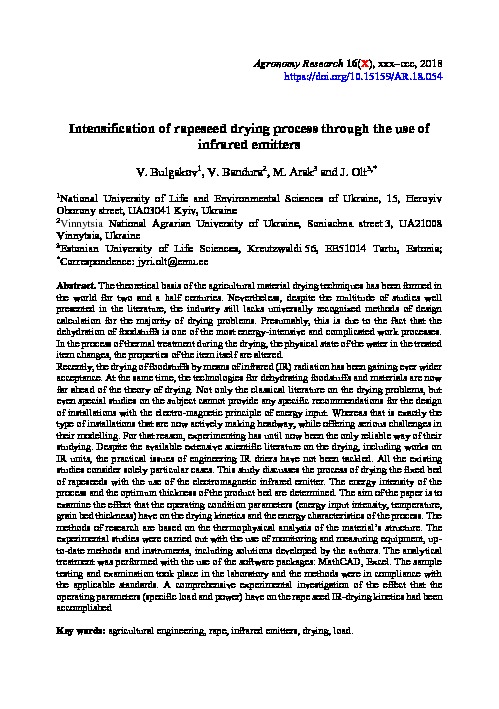id: 16451
Title: Intensification of rapeseed drying process through the use of infrared emitters
Authors: Bulgakov V., Bandura V., Arak M., Olt G.
Keywords: agricultural engineering, rape, infrared emitters, drying, load
Date of publication: 2018-06-21 09:02:22
Last changes: 2018-06-21 09:02:22
Year of publication: 2018
Summary: Abstract. The theoretical basis of the agricultural material drying techniques has been formed in the world for two and a half centuries. Nevertheless, despite the multitude of studies well presented in the literature, the industry still lacks universally recognized methods of design calculation for the majority of drying problems. Presumably, this is due to the fact that the dehydration of foodstuffs is one of the most energy-intensive and complicated work processes. In the process of thermal treatment during the drying, the physical state of the water in the treated item changes, the properties of the item itself are altered.
Recently, the drying of foodstuffs by means of infrared (IR) radiation has been gaining ever wider acceptance. At the same time, the technologies for dehydrating foodstuffs and materials are now far ahead of the theory of drying. Not only the classical literature on the drying problems, but even special studies on the subject cannot provide any specific recommendations for the design of installations with the electro-magnetic principle of energy input. Whereas that is exactly the type of installations that are now actively making headway, while offering serious challenges in their modelling. For that reason, experimenting has until now been the only reliable way of their studying. Despite the available extensive scientific literature on the drying, including works on IR units, the practical issues of engineering IR driers have not been tackled. All the existing studies consider solely particular cases. This study discusses the process of drying the fixed bed of rapeseeds with the use of the electromagnetic infrared emitter. The energy intensity of the process and the optimum thickness of the product bed are determined. The aim of the paper is to examine the effect that the operating condition parameters (energy input intensity, temperature, grain bed thickness) have on the drying kinetics and the energy characteristics of the process. The methods of research are based on the thermophysical analysis of the material’s structure. The experimental studies were carried out with the use of monitoring and measuring equipment, up-to-date methods and instruments, including solutions developed by the authors. The analytical treatment was performed with the use of the software packages: MathCAD, Excel. The sample testing and examination took place in the laboratory and the methods were in compliance with the applicable standards. A comprehensive experimental investigation of the effect that the operating parameters (specific load and power) have on the rape s
URI: http://socrates.vsau.edu.ua/repository/getfile.php/16451.pdf
Publication type: Статті Scopus
Publication: Agronomy Research. - 2018. - Vol. 16, № 2. - P. 349-356.
In the collections :
Published by: Адміністратор
File : 16451.pdf Size : 607547 byte Format : Adobe PDF Access : For all

| |
|
|